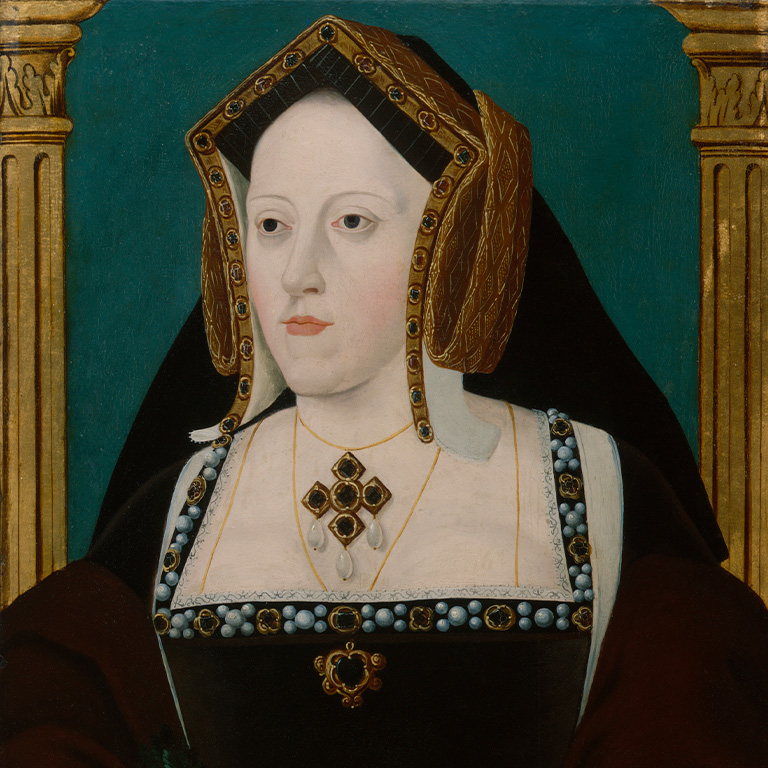Catherine of Aragon
Catherine of Aragon
Catherine of Aragon was Queen of England and the first wife of Henry VIII. She is remembered as a pivotal figure of the English reformation and as a strong-willed, religious woman.
Early Life
Catherine was born in Castile, Spain on 16th December 1485. She was the daughter of Isabela I, Queen of Castile and Ferdinand II, King of Aragon. She was given a stellar education; she studied a range of subjects including arithmetic, law and history. She had a strong religious upbringing. Catherine could read and write in both Spanish and Latin and was able to speak Spanish, English, French and German.
Life in England.
From childhood, Catherine was intended to marry into another European royal family to strengthen Spain’s ties across Europe. On 4th November 1501, she travelled to London at fifteen years of age and met her future husband, Prince Arthur Tudor, heir to the English throne. They were married just ten days later! Sadly, on the 2nd April the following year, Prince Arthur died of the sweating sickness, leaving Catherine a widow at just sixteen years old. After the King of England, Henry VII died, his younger son was crowned King Henry VIII. Henry decided to marry Catherine himself and, after seeking permission from the Pope to marry his brother’s wife, they were married on 11th June 1509. Catherine was crowned Queen of England a few weeks later and was greeted by an enthusiastic crowd of supporters at her coronation.
Queen of England
Catherine was a popular queen. The public viewed her as compassionate and generous, as well as strong and virtuous. In an era where men held all the power, Catherine was considered intelligent enough to express her views and be heard amongst the men of court, impressing even her enemies with her determination and dedication. Catherine fell pregnant seven times during her marriage to Henry, but as was typical for the time, sadly only one child survived past infancy: a daughter, Mary. Henry was desperate for son to carry on his legacy and grew impatient with Catherine for not fulfilling this desire.
The Reformation
In 1525, Henry met and fell in love with Anne Boleyn, one of Catherine’s ladies in waiting. Catherine was now considered by medical professionals of the time to be too old to have any more children, so Henry decided that he would divorce Catherine and make Anne his new queen. The Catholic Church did not allow divorce, so Henry pleaded with the Pope to annul his marriage. The Pope refused, supporting Catherine as Henry’s rightful and forever wife. This led to a chain of events that would change the face of religion in England from that point onwards, known as the Reformation. Having been refused a divorce from the Pope, Henry decided to break away from the Catholic Church in Rome and create the Church of England, of which he would be the head. In doing this, Henry could grant himself a divorce without needing the Pope’s permission. He divorced Catherine and married Anne. Catherine was ordered to renounce the title of queen and take the title of ‘Dowager Princess of Wales’ due to her being a widow of Henry’s brother Arthur. Catherine refused to accept the divorce as it had not been granted by the Pope and continued to call herself the Queen of England.
Later Life and Death
In the winter of 1531, Catherine was ordered to move to a new home for refusing to accept the divorce. She spent the rest of her life there, keeping to only one room except to pray. She received very few visitors and was forbidden from seeing her daughter. Catherine was offered the chance to see Mary if she accepted Anne as the new queen, but she refused. In December 1535, Catherine’s health started to fail and she wrote to Henry one final time, asking him to be a good father to their daughter. On 7th January 1536, Catherine died aged 50 of what is now believed to be cancer of the heart. It was reported that doctors found a black growth on her heart after she died, leading many at the time to believe she had been poisoned. News of Catherine’s death sent widespread mourning across England and Europe as, despite the divorce, she was still a popular figure with many people. Catherine was buried in Peterborough Cathedral and had an elaborate funeral ceremony, appropriate for her position as Dowager Princess of Wales.



A super piece of writing – well done!
Thank you! 🙂